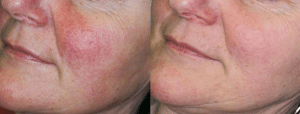Facial Redness: Triggers and Treatments
 Facial redness is one of the most common and most embarrassing dermatologic issues. While many skin diseases can result in redness, most people with chronic, recurrent flushing suffer from rosacea.
Facial redness is one of the most common and most embarrassing dermatologic issues. While many skin diseases can result in redness, most people with chronic, recurrent flushing suffer from rosacea.
Rosacea usually begins after age 30 and presents with recurrent redness on the cheeks, forehead, nose, and chin. Over time, visible blood vessels (telangiectasias) appear and become persistent.
Red pimples and pustules can appear. In severe cases, if left untreated, the skin may thicken into a variant called rhinophyma. Many patients who suffer from rosacea experience eye irritation, called ocular rosacea. Management of rosacea begins with identifying triggers, proper skin care, medications, and lasers.
Facial RednessTriggers
Many environmental triggers can flare rosacea. It is advisable that patients keep a diary to learn which are most significant for them. Common triggers of rosacea include:
- sun exposure
- caffeine
- hot beverages
- spicy food
- alcohol (specifically red wine)
- exercise
- stress
- extremes in temperature
Proper skin care for rosacea prone skin should be simple and gentle. Ideally, aside from prescribed topicals, patients should only use 3 products: a fragrance free cleanser, an oil free moisturizer containing niacinamide (Vitamin B3) and a physical sunscreen. Potential irritants like fragrance, scrubs, cleansing brushes, and make up wipes should be avoided.
Facial Redness Treatment Options
Treatment of rosacea depends on the subtype and severity. Milder cases often respond to sulfur based washes, metronizadole cream, azeleic acid or anti-inflammatories like pimecrolimus (Elidel). For patients with papulopustular rosacea, adding an oral antibiotic and/ or toical ivermectin (Soolantra) may be necessary. For early rhinophyma, isotretinoin can prevent progression.
Other medications, brimonidine (Mirvaso) and oxymetazoline (Rhofade), can be used like Visine is used for the eyes – to temporarily decrease redness before an event.
Despite proper skincare and treatment, many patients experience persistent redness and permanent telangiectasias. In these cases, intense pulsed light (IPL) has tremendous efficacy. IPL diminishes redness and reduces the appearance of blood vessels. Since rosacea is a chronic condition, patients benefit most from treatments at regular, spaced out intervals.
Over time, IPL can help reduce dependence on medications. IPL is generally very well tolerated. After a treatment, patients can expect to have an immediate sunburn-like redness with mild swelling that resolves quickly. It should be avoided in darker skin types and in skin that is tanned.
For patients with rosacea, knowledge is power. Understanding triggers, implementing proper skin care, and a following a tailored treatment regimen can truly alter the course of the condition and the appearance of the skin.
Eliminate Facial Redness with Treatment from Spring Street Dermatology in NYC
To learn more about treatment options for facial redness, contact Spring Street Dermatology in SOHO and Uptown, NYC to schedule a consultation. You can also schedule an appointment online here.
